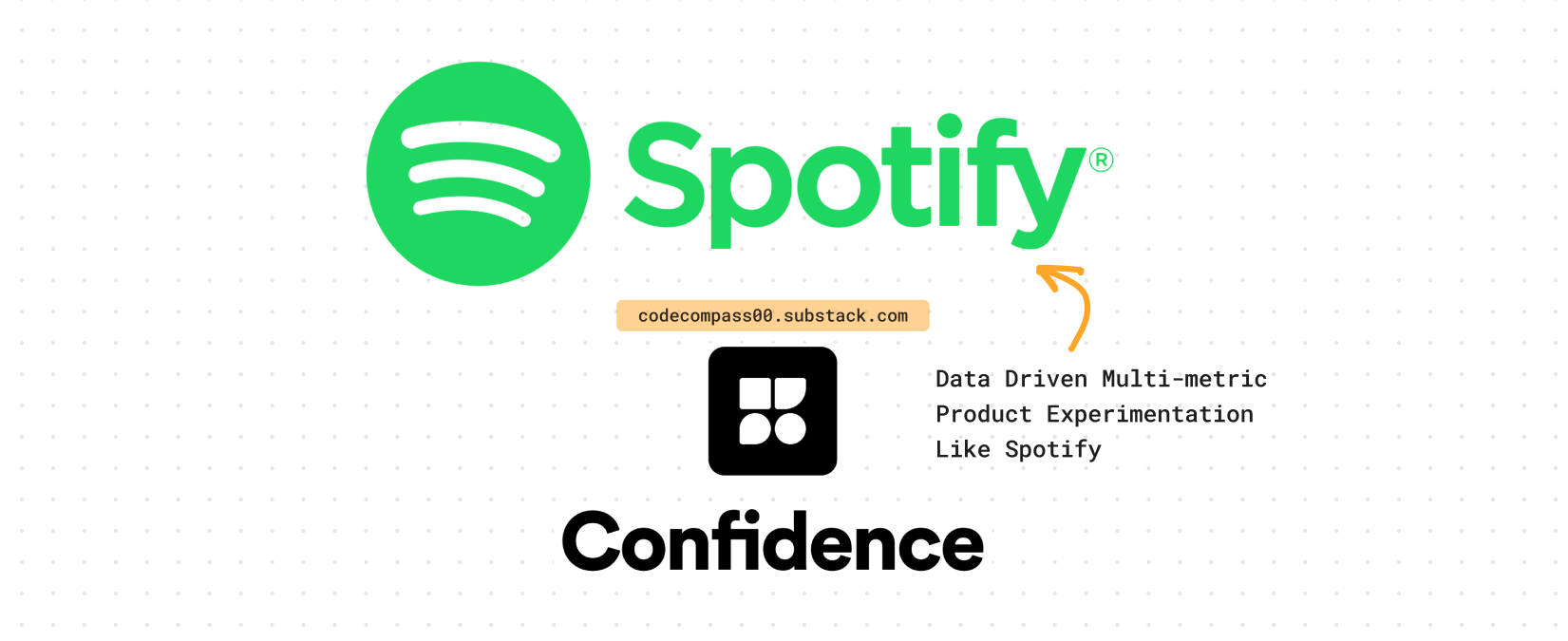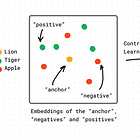Confident Product Decisions with Data: Inside Spotify’s Risk-Aware A/B Testing Framework
Learn how Spotify’s multi-metric evaluation strategy can enhance your A/B testing and drive innovative product decisions.
Get a list of personally curated and freely accessible ML, NLP, and computer vision resources for FREE on newsletter sign-up.
Consider sharing this with someone who wants to know more about machine learning.
A/B testing is a cornerstone of product decision-making in tech companies. To navigate the complexities of evaluating multiple metrics, Spotify’s experimentation team offers a robust framework. Spotify calls it “Confidence” and you can get started with the framework here: Confidence [2].
The technical details are covered in Spotify’s paper “Risk-aware product decisions in A/B tests with multiple metrics” [1].
Today, we take a deep dive into Spotify’s framework for A/B testing with multiple metrics to drive product decisions.
In the hype that surrounds LLMs, there is a big question mark: how to best evaluate these models which are being released at break neck pace.
Or you can read more about the Transformers series and LLMs series or:
1. Motivation
“By articulating the heuristics that govern your decision-making process, you can design and analyze the experiment in a way that respects how you make decisions in the end. That’s not the only benefit of applying decision rules, though. There are two other key perks of the decision-rule framework that stand out, particularly when considering an experimentation platform as a centralized tool.
The first advantage is that a coherent and exhaustive way of automatically analyzing experiments is crucial for standardizing product decisions made from A/B tests…
A second advantage is that because the decision rule exhaustively maps all possible outcomes to a decision, we can give constructive guidance on the product implication of the results — without having to dive into any specific metric results…
Experimentation is, and should be, a team sport. This reduces the need for data science expertise to correctly interpret experiment results.” [3]
In the fast-paced world of product development, making data-driven decisions is crucial. Traditional A/B testing often focuses on a single metric, but modern products require a more nuanced approach. Spotify recognized the need for a framework that could handle multiple metrics, ensuring that product decisions are both innovative and risk-aware.

2. Scoping the Problem
Real-world data is messy and constantly changing, which poses significant challenges for models. Just as Tesla captures rare events to improve its self-driving technology, Spotify's framework aims to gather comprehensive data across multiple metrics. This approach addresses both common and edge-case scenarios, minimizing risks and enhancing model reliability.
3. The Solution
Spotify's framework for A/B testing revolves around a comprehensive multi-metric evaluation strategy that ensures data-driven and risk-aware product decisions. Here’s a deeper dive into the technical details of the solution:
Metric Categorization
Spotify's framework categorizes metrics into four types:
Success Metrics: These are the primary metrics that the new feature aims to improve. They are tested using superiority tests, which determine if the treatment group performs significantly better than the control group.
Guardrail Metrics: These metrics ensure that while improving success metrics, other critical aspects of the product are not negatively impacted beyond an acceptable threshold. Guardrail metrics are evaluated using non-inferiority tests.
Deterioration Metrics: These metrics ensure that the treatment does not cause any significant negative impacts. They are tested using inferiority tests, which detect if the treatment group is performing worse than the control group.
Quality Metrics: These metrics verify the integrity and validity of the experiment itself, such as ensuring the proper distribution of users in control and treatment groups through tests like sample ratio mismatch.

Decision Rules
The heart of Spotify’s framework lies in its decision rules for product deployment:
Decision Rule 1: Deploy if at least one success metric is significantly superior and all guardrail metrics are non-inferior.
Decision Rule 2: An extension of Rule 1, ensuring no success, guardrail, or deterioration metrics are significantly inferior, and no quality tests fail.
These rules ensure a balanced evaluation by considering both positive impacts and potential risks.
Error Rate Management
Managing type I and type II error rates is crucial to maintaining the integrity of the decision-making process:
Type I Error (False Positive): To control the family-wise error rate, significance levels for individual tests are adjusted.
Type II Error (False Negative): Ensuring sufficient power for detecting true effects is essential, especially for non-inferiority tests. This involves adjusting the power calculations to account for multiple comparisons, ensuring that the probability of missing a true effect (type II error) is minimized.
Implementation of Decision Rules
The implementation involves several steps:
Experiment Design: Define the metrics and their respective tests before running the experiment. Clearly outline the hypotheses for success, guardrail, deterioration, and quality metrics.
Data Collection: Conduct the A/B test, collecting data for all predefined metrics.
Statistical Analysis: Apply the appropriate statistical tests (superiority, non-inferiority, inferiority) to the collected data. Adjust significance levels to control error rates.
Decision Making: Use the predefined decision rules to evaluate the test results and make an informed decision about deploying the product change.
Monte Carlo Simulations
Monte Carlo simulations are employed to validate the theoretical results and ensure that the decision rules and error management strategies are effective in real-world scenarios. These simulations involve running numerous iterations of the A/B tests with varying conditions to assess the robustness and reliability of the framework.
By adopting these detailed decision rules and error management strategies, Spotify ensures that product decisions are both data-driven and risk-aware, balancing the need for innovation with the necessity of maintaining product quality and integrity.
4. Design Choices
In developing Spotify's A/B testing framework, several crucial design choices were made to balance robustness, efficiency, and practicality. These choices ensure that the testing framework not only provides reliable results but also integrates seamlessly into Spotify's existing infrastructure.
Metric Selection and Categorization
Diverse Metrics for Comprehensive Evaluation:
Success Metrics: Focused on the primary goals of the experiment, such as user engagement or feature adoption.
Guardrail Metrics: Protect against negative impacts on critical aspects like user retention or revenue.
Deterioration Metrics: Detect regressions in key areas to prevent unintended consequences.
Quality Metrics: Ensure the experiment's integrity and validity, such as sample ratio mismatch checks.
Each metric category serves a specific purpose, providing a holistic view of the experiment's impact. This categorization allows for targeted testing strategies that align with different business objectives.
Statistical Testing and Error Management
Superiority Tests: For success metrics, to confirm improvements.
Non-inferiority Tests: For guardrail metrics, ensuring changes do not exceed acceptable negative thresholds.
Inferiority Tests: For deterioration metrics, identify any significant regressions.
The choice of test type is critical. Superiority tests require demonstrating statistically significant improvements, while non-inferiority and inferiority tests focus on maintaining existing performance standards.
Error Rate Adjustments
Adjustments to significance levels and power calculations are essential for maintaining the balance between detecting true effects and avoiding false positives.

Implementation Strategy
Define hypotheses for each metric.
Determine appropriate statistical tests and significance thresholds.
Plan data collection and analysis procedures.
Clear planning ensures that the experiment design aligns with business goals and scientific rigor, reducing the risk of bias or misinterpretation.
Data Handling and Analysis
Collect data systematically, ensuring completeness and accuracy.
Apply statistical tests as planned, adjusting for multiple comparisons.
Interpret results in the context of pre-defined decision rules.
Systematic data handling and rigorous analysis protocols ensure that results are reliable and actionable.
Scalability and Integration
The ability to scale ensures that the framework remains effective and efficient as the volume and complexity of A/B tests increase.
Design the framework to handle multiple simultaneous experiments.
Ensure that the framework can scale with the organization's growth and increasing complexity of tests.
Integration reduces overhead and ensures that the framework can leverage existing technological investments, facilitating smoother adoption and operation.
Seamlessly integrate the framework into existing data pipelines and experimentation platforms.
Ensure compatibility with current data storage, processing, and analysis tools.
Practical Considerations
User-friendly interfaces democratize data-driven decision-making, enabling broader organizational participation and understanding.
Develop interfaces that allow non-technical stakeholders to interact with the framework easily.
Provide clear visualizations and summaries of test results.
Continuous Improvement
Regularly review and refine the framework based on feedback and evolving needs.
Incorporate new statistical methods and technologies as they become available.
Continuous improvement ensures that the framework stays current with best practices and technological advancements, maintaining its effectiveness and relevance.
By making these thoughtful design choices, Spotify has created a robust, scalable, and user-friendly A/B testing framework that supports data-driven and risk-aware product decisions. This framework ensures that decisions are made based on comprehensive, accurate, and relevant data, ultimately driving better product outcomes.
5. Deployment and Practical Usage
For machine learning professionals and product managers, this framework offers a robust method for evaluating A/B tests with multiple metrics:
Comprehensive Evaluations: Assess features not just on success metrics but also on their impact on guardrail, deterioration, and quality metrics.
Risk Mitigation: Minimize the chances of incorrect decisions by managing type I and type II error rates effectively.
Standardized Processes: Apply a standardized approach to A/B testing across your organization, ensuring consistent and reliable product decisions.
The framework’s effectiveness is demonstrated using Monte Carlo simulations, validating the decision rules and error management strategies in real-world scenarios. This practical approach ensures that the theoretical benefits translate into tangible improvements in product decision-making.
Outro
Spotify’s framework for risk-aware product decisions in A/B tests provides a structured and effective approach to multi-metric evaluations. By integrating these principles into your in-house model evaluation and deployment platform, you can enhance the robustness and reliability of your product decision-making process.
This approach not only benefits product managers and data scientists but also sets a standard for rigorous, data-driven decision-making in the tech industry.
See you in the next edition of the Code Compass.
Until then you can read more on the Transformers series, LLMs series, Leveling Up! or one of the following case studies:
References
Risk-aware product decisions in A/B tests with multiple metrics: https://arxiv.org/abs/2402.11609
Spotify’s Confidence: https://confidence.spotify.com/blog/experiment-like-spotify
Consider subscribing to get it straight into your mailbox:











